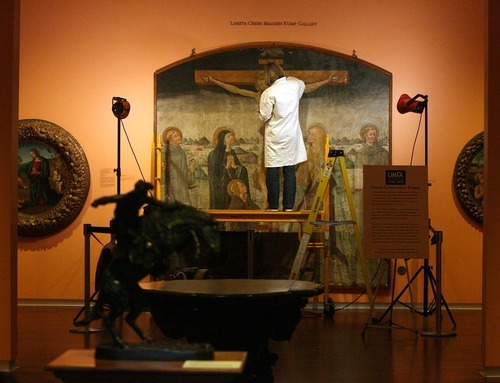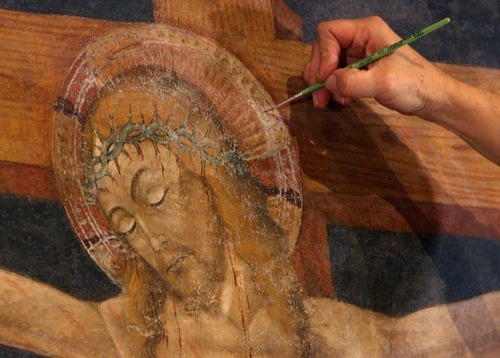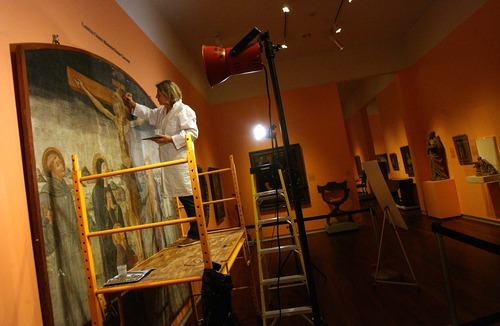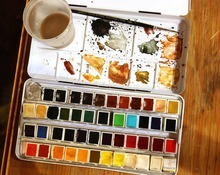This is an archived article that was published on sltrib.com in 2012, and information in the article may be outdated. It is provided only for personal research purposes and may not be reprinted.
When the hunt was on for a new Utah Symphony music director in 2008, the search committee sought an exceptional artist who would plunge into Utah's community life with zest.
As the second season of Thierry Fischer's tenure nears a close, it's clear that two such people were found, said Utah Symphony | Utah Opera board president Patricia Richards.
Fischer's success as the Utah Symphony's music director has attracted a bright spotlight. Meanwhile, Catherine Orange Fischer has made her mark, and not just because of her husband. A gifted art conservator, she donated three months of her time over the past year toward restoring the beauty of an Italian Renaissance fresco owned by the Utah Museum of Fine Arts.
Richards describes the Fischers as grounded individuals who believe in hard work, family solidarity and giving back to the community. Things could hardly have worked out better, she said.
"Our first goal was to have a musician of highest artistic quality and vision to lead the Utah Symphony as its music director," Richards said. "Secondarily, we really did want someone who would enjoy being here, and be engaged in the community. We had no idea we would be so lucky as to get a team who are both qualified in their own artistic fields. Both have far exceeded our original expectations."
—
Beauty uncovered • Catherine Fischer is a warm, down-to-earth woman fervidly devoted to artistic expression. She spent a 30-year career restoring art works in Europe, but never had the chance to lead restoration of a work such as Polidoro di Bartolomeo's 1480 fresco "Crucifixion with Saints."
"For me, it's a huge chance to work on this," Fischer said. "It's not something I could have done in Switzerland. It is really touching [to] me — he was a good painter."
Utah Museum of Fine Arts director Gretchen Dietrich said Fischer worked steadily from 8 a.m. to 4 p.m. over three months. She stabilized the backing of the fresco, then painstakingly swabbed the grime from its time-worn surface. Where flecks of paint had chipped away, she matched pigments, then added color with meticulous care.
Gradually, lovely details emerged from obscurity, each noted in Fischer's report documenting the process. The restored fresco is on display in the museum now, with its original splendor intact.
"A conservation expert like Catherine is almost like a doctor," Dietrich said. "She can bring works of art back to life that would otherwise be lost over time, and that's incredibly important. This fresco now seems like a new object. It looks much as it would have when it was made in 1480."
—
Catherine's niche • Dietrich said the museum lacked funds to bring in a conservator for the fresco project, estimating it would have cost $35,000 to $50,000.
"Our community will benefit for many, many years from this gift of hers," Dietrich said, as Catherine Fischer donated her time and expertise to the museum. "We're thrilled to have this done without using up our resources. The fact that Catherine is delightful to be around is a huge bonus."
Thierry Fischer said it's important for Catherine to have a satisfying artistic life of her own.
"I'm so happy to go home after a day of rehearsal, and she's had a great day in the museum, meeting fantastic people and making interesting connections," the conductor said. "She really wanted to know people differently than just following me around and going to dinners where she is introduced as 'the wife of. …' For us to be involved in different things in the community — she in the visual arts and me in sound arts — gives full sense to us being here."
The Fischers are parents of three grown sons who have warm, relaxed relationships with their parents and like visiting Utah for family ski days.
The chance for a life that suits his family's needs helped Fischer choose Utah from several offers in the States, although his desire to follow the footsteps of conductor Maurice Abravanel topped the list of reasons for accepting the Utah Symphony post, he said.
The serendipitous relationship between Catherine and UMFA developed after his tenure here began, cementing the choice. "We feel we are part of the community, even if we are only here four or five months out of the year," Fischer said. "We honestly feel at home more and more."
—
The symphony and more • Like other prominent conductors, Fischer has multiple commitments. He is principal conductor of the BBC National Orchestra of Wales through the end of this season and is busy as a guest conductor around the world. Still, he and Catherine purchased a home in Salt Lake City and have lived up to their commitment to spend about one-third of the year here, spread over several monthlong trips.
Although Fischer spends most of his time while in Utah at Abravanel Hall, he's finding his own ways to contribute to Utah's community life.
Next month, he'll conduct a concert on the NOVA Chamber Music Series, which features professional musicians living in Utah. The series' director, Utah Symphony pianist Jason Hardink, said Fischer was tremendously excited about the chance to appear outside his normal role and meet other musicians.
"The really generous thing is that he's appearing on NOVA and refuses to accept a fee for it," Hardink said. "That's a very big donation to the series, as someone of his stature costs a lot of money to book."
The Fischers are naturally generous people, and that attitude has become contagious among members of the Utah Symphony, Hardink said, although the pace Fischer sets is hard to match.
"I take greater pride in my preparation with him up there," Hardink said. "I don't want to disappoint him, and I want to contribute in a meaningful way because of his leadership."
—
What they do for love • Hardink said the stress level among Utah Symphony players is higher these days, but in the best possible way.
"After he's been here three or four weeks in a row, we're pretty exhausted," he said. "But that's what you want — to be giving all you've got. He is demanding that."
Grueling rehearsals aren't the only thing on Fischer's schedule while in Utah. "He is meeting with community leaders, having dinners and meetings and speaking at the Legislature," Hardink said. "Every moment that he is not on the podium, he is out in the community talking to people and garnering support. He does more reaching out in that way than any other artistic director-type I've seen in my life. It's incredible."
When Fischer speaks, it's obvious he and Catherine came to Utah full of optimism about possibilities here, and willing to work hard at contributing. It's an attitude Abravanel, who built the Utah Symphony from a community group to a world-class orchestra, would approve.
"The culture and arts of this place is actually unique if you compare it with similar-size cities in America," Fischer said. "The commitment and the artistic level in this community is very, very special. We feel very well here. We've met great people, and we are proud to be part of it and to give what we can."
Dietrich said knowing Catherine Fischer helps her understand the motivation behind the generosity and enthusiasm the Fischers emanate.
"I think people who spend their lives as she and Thierry have, working in the arts, don't do it for money or fame," Dietrich said. "They do it because there is no other way to live one's life."
facebook.com/nowsaltlake —
Resurrecting 'Crucifixion With Saints'
Polidoro di Bartolomeo's "Crucifixion With Saints" is on display at the Utah Museum of Fine Arts' European gallery — the LaReta Creer Madsen Kump Gallery — on the second floor. It was restored by art conservator Catherine Orange Fischer, who volunteered her expertise to remove cracks and dirt from the artwork.
The fresco was painted in 1480 on the wall of an unknown Italian church and later transferred to canvas. William Randolph Hearst purchased it in 1929 from a New York gallery and later gave it to the Los Angeles County Museum of Art. The fresco was sold to a Salt Lake City gallery around 1967 and later acquired by Garner D. Irvine. In 1984, Irvine gave the painting to the museum as a partial gift, with additional funds to complete the acquisition provided by LaReta Creer Kump.
Where • UMFA, 410 Campus Center Drive, Salt Lake City; 801-581-7332
Hours • Tuesday-Friday, 10 a.m.-5 p.m.; Wednesday, 10 a.m.-8 p.m.; Saturday-Sunday, 11 a.m.-5 p.m. Closed Mondays and holidays/
Admission • UMFA members free; $7, adults; $5, seniors/youth/Utah college students; free, children under 6 and military families











